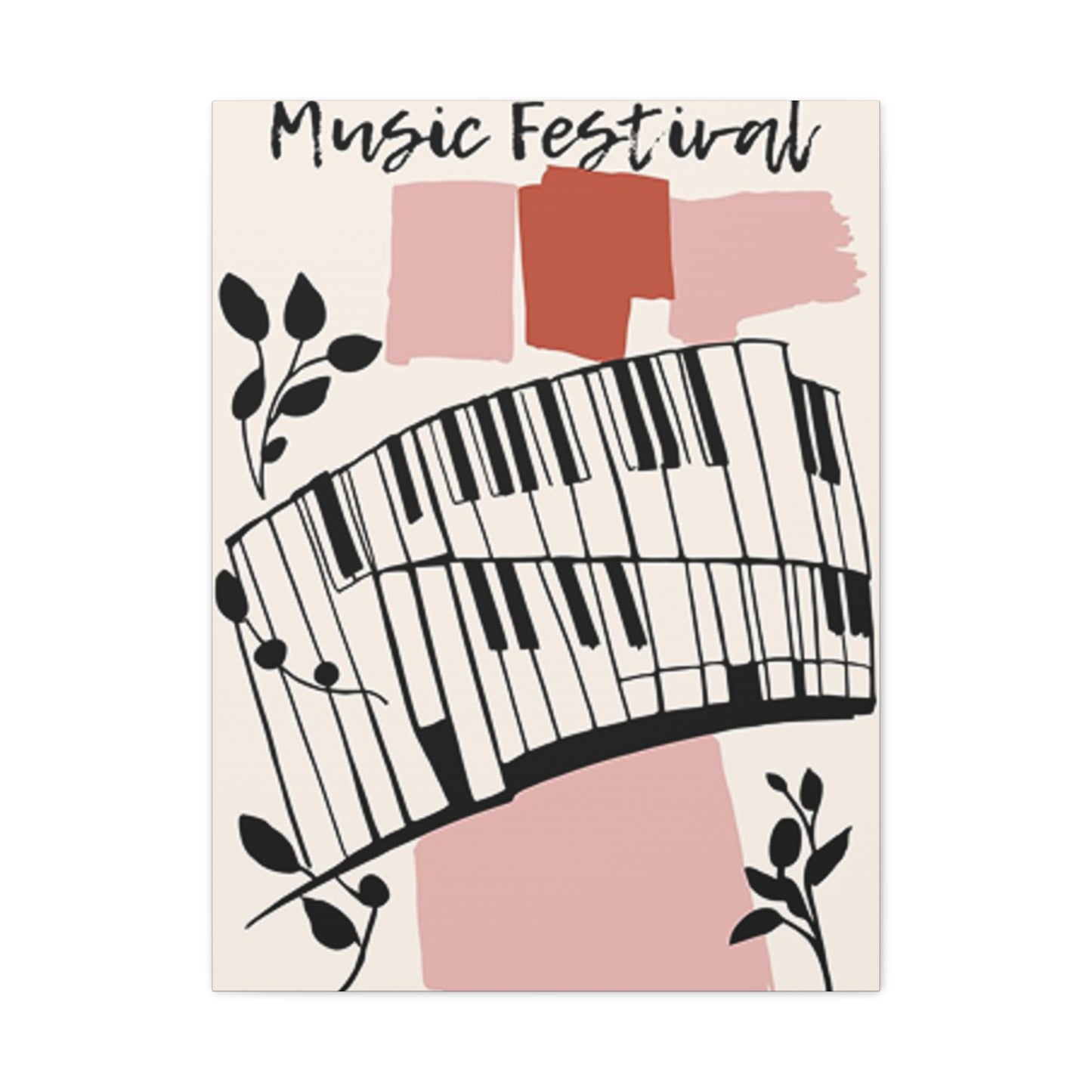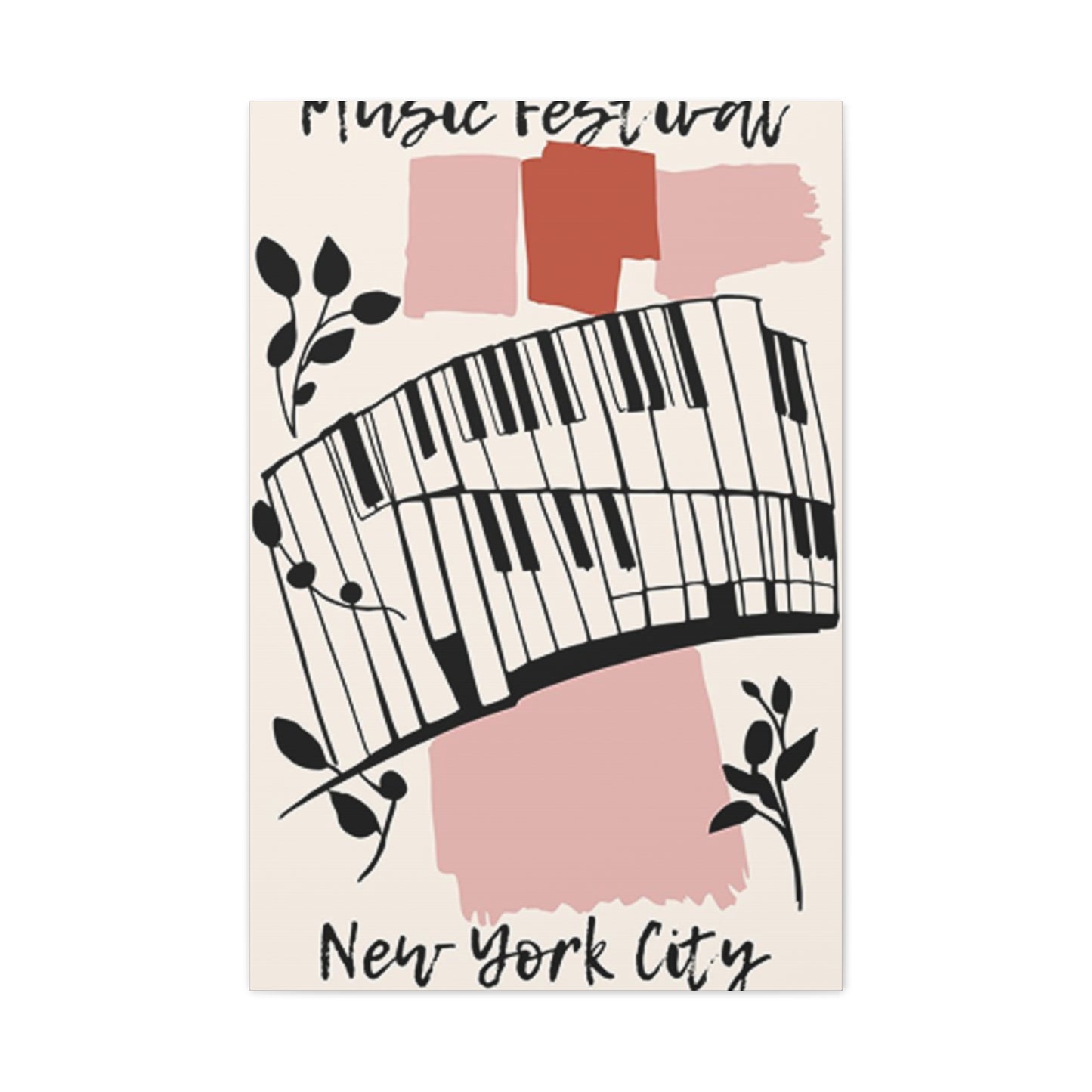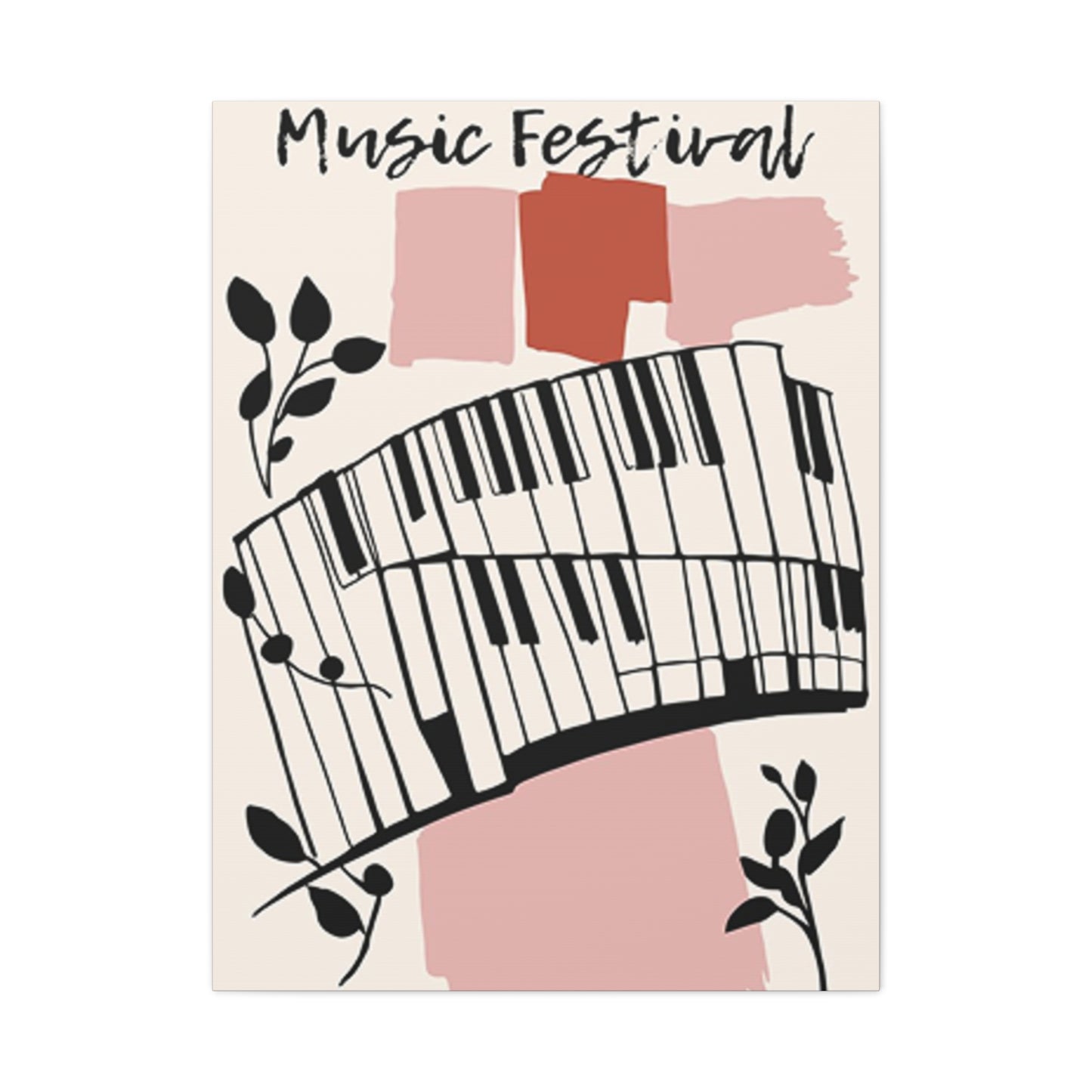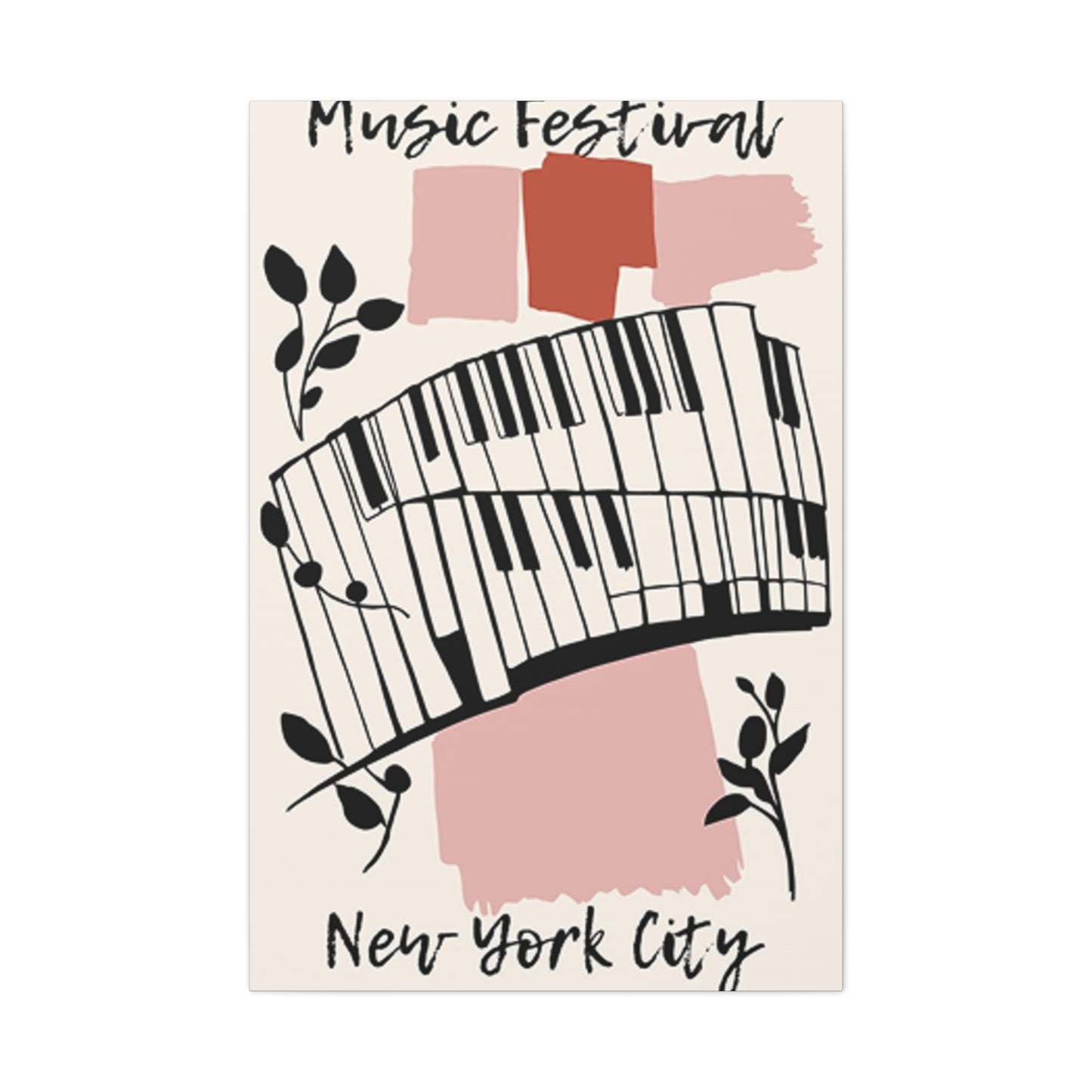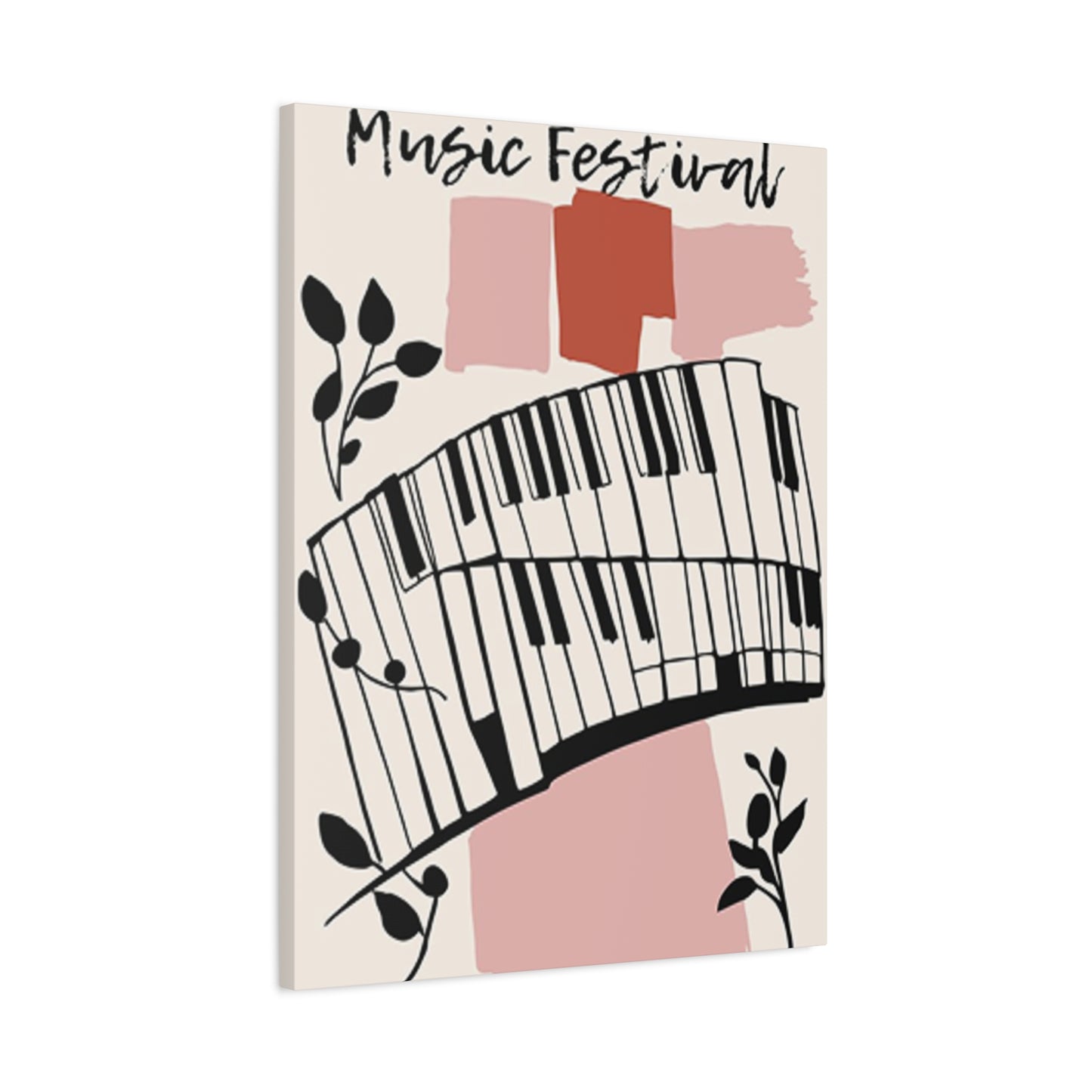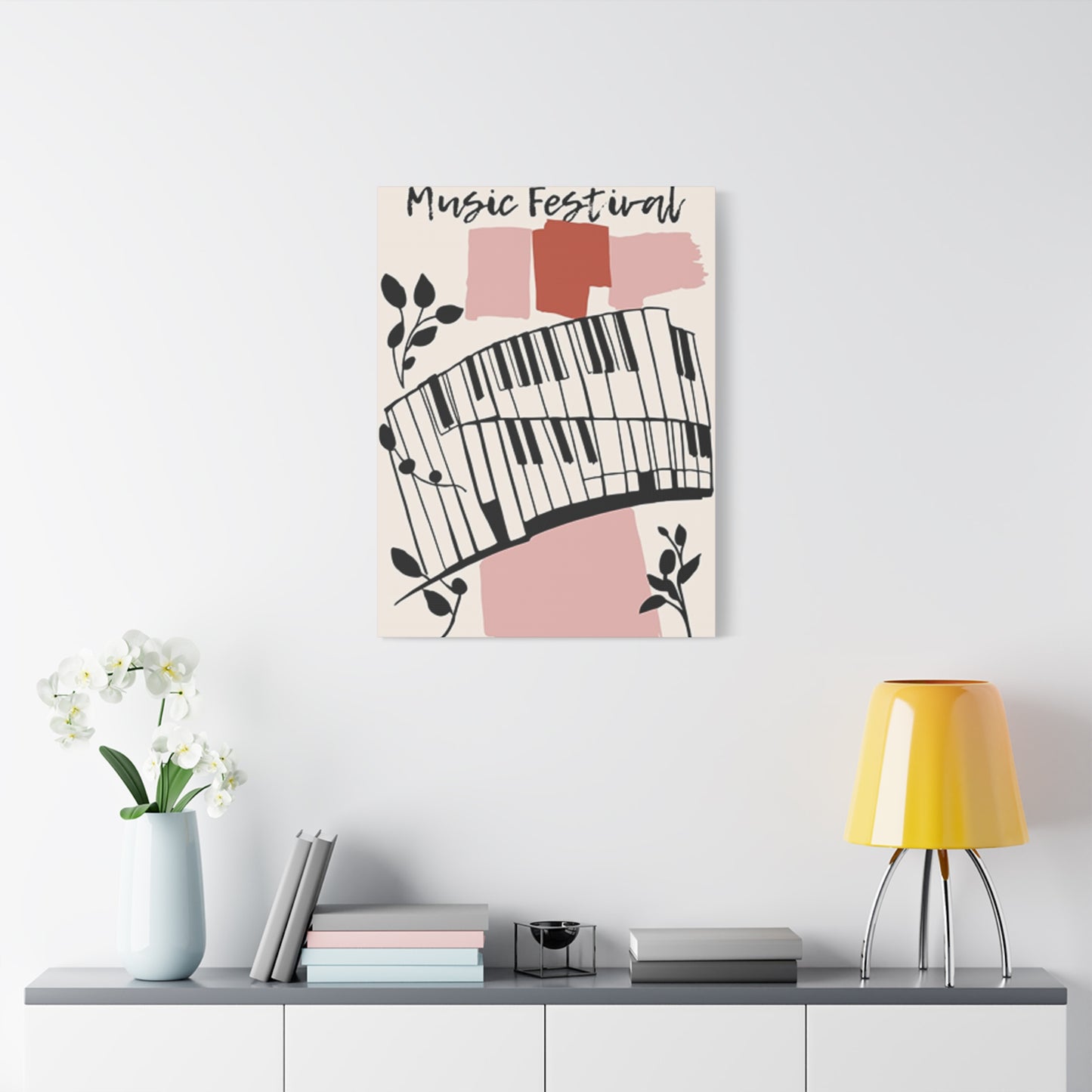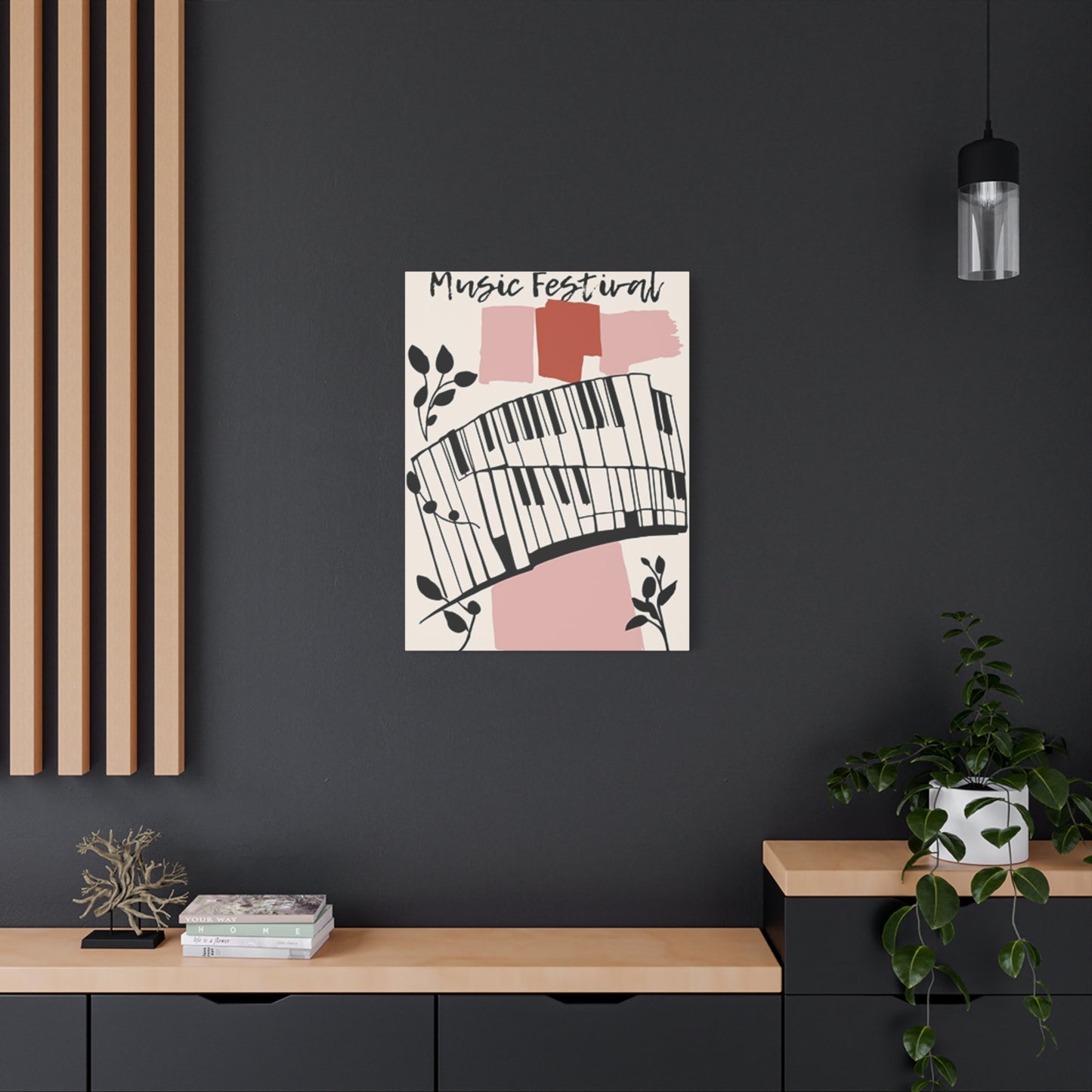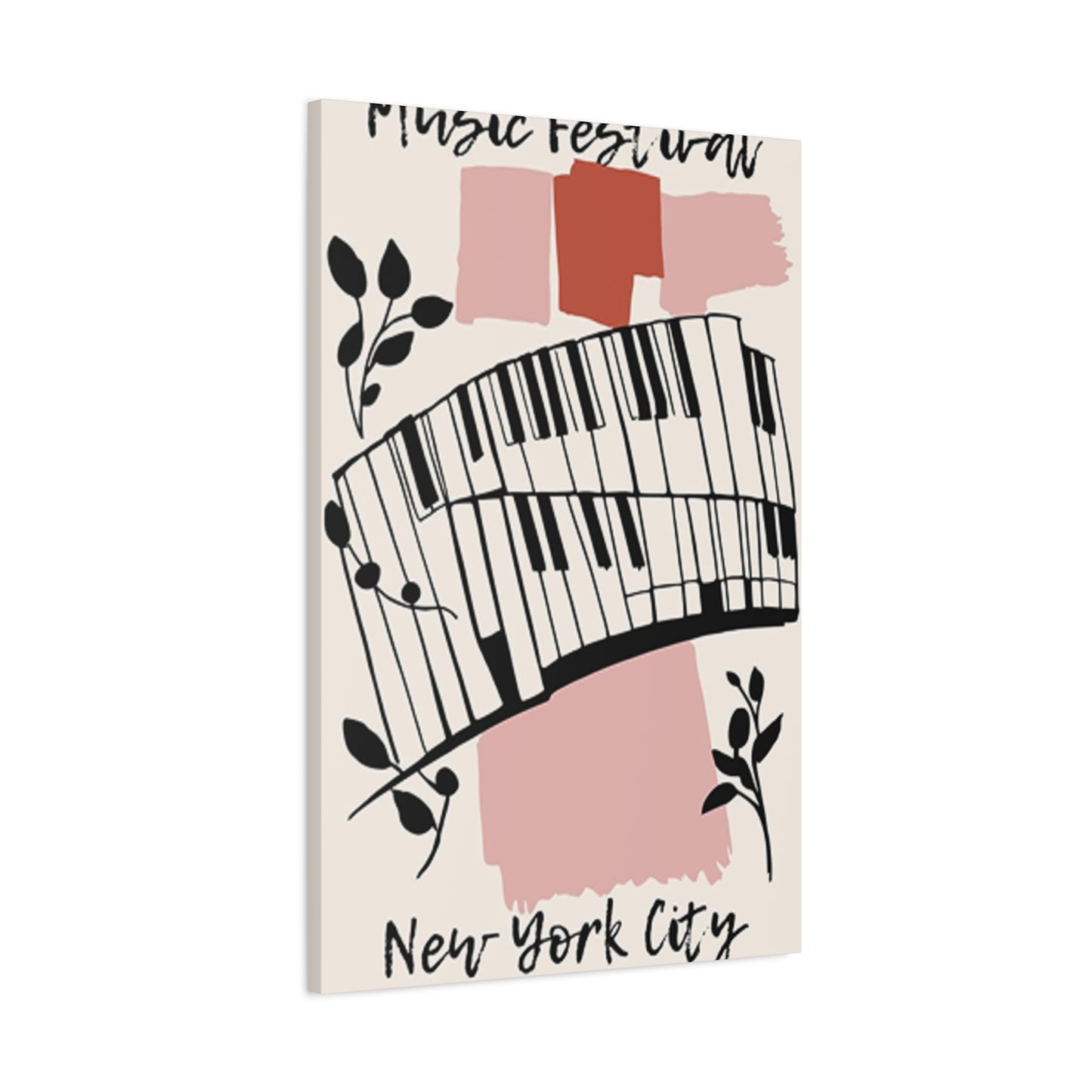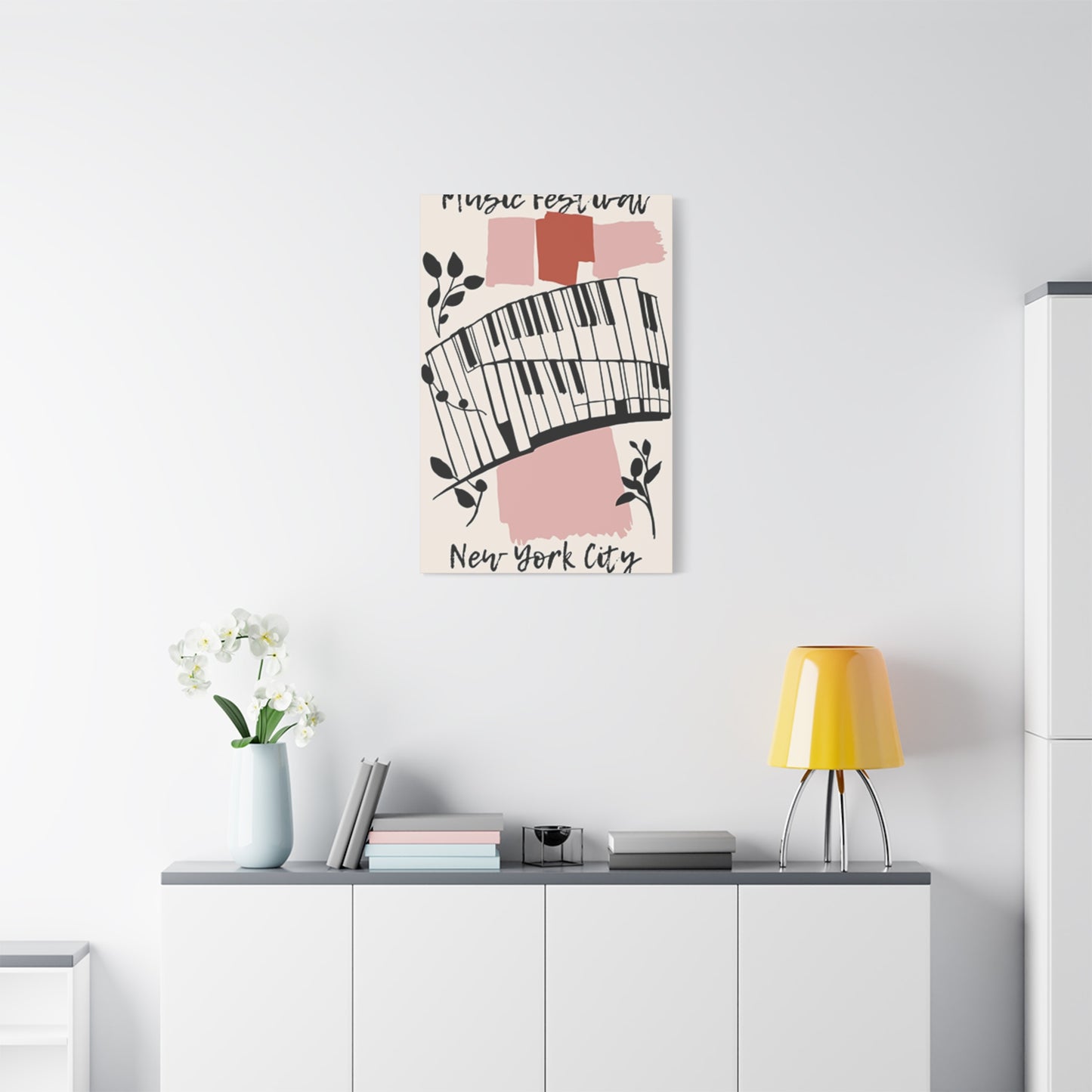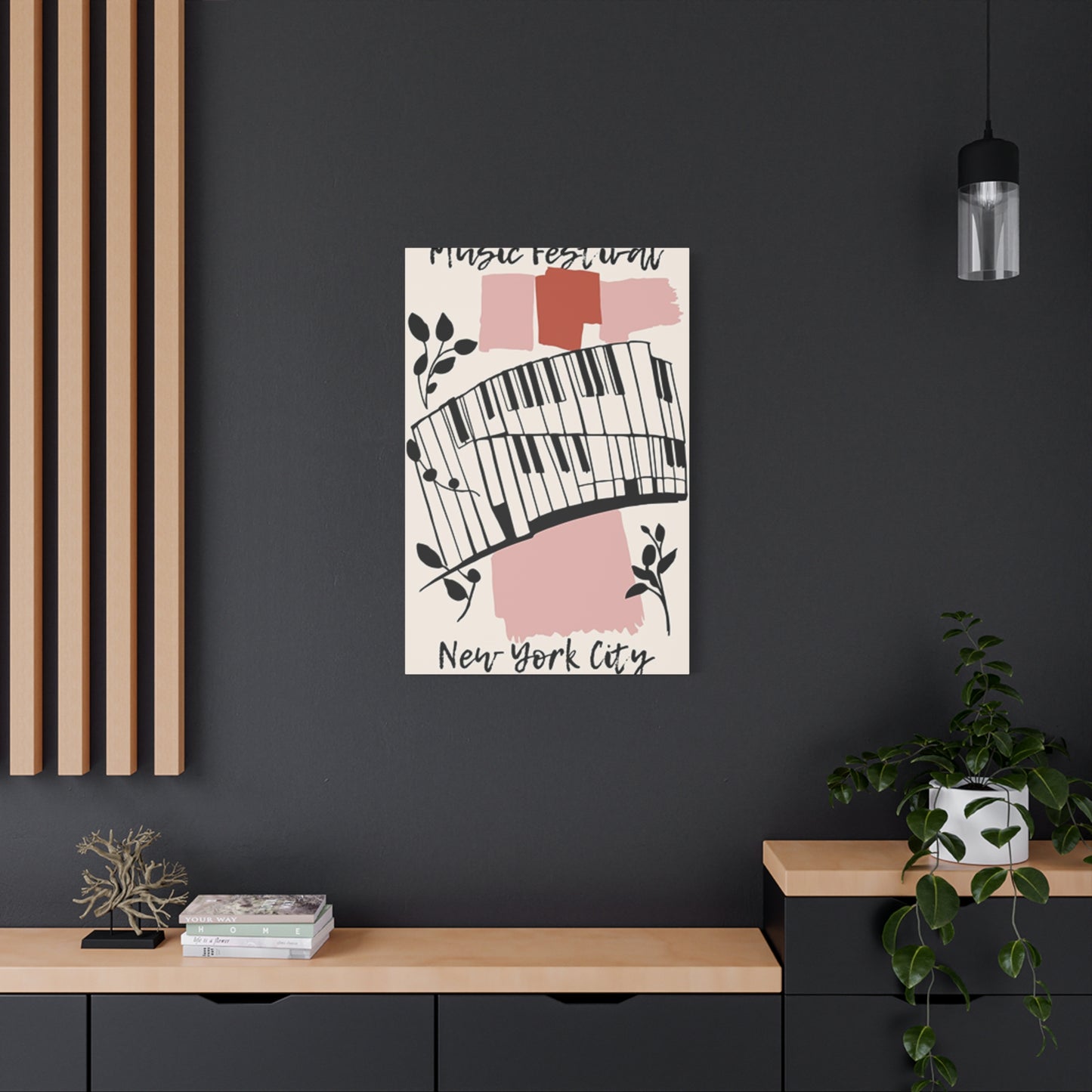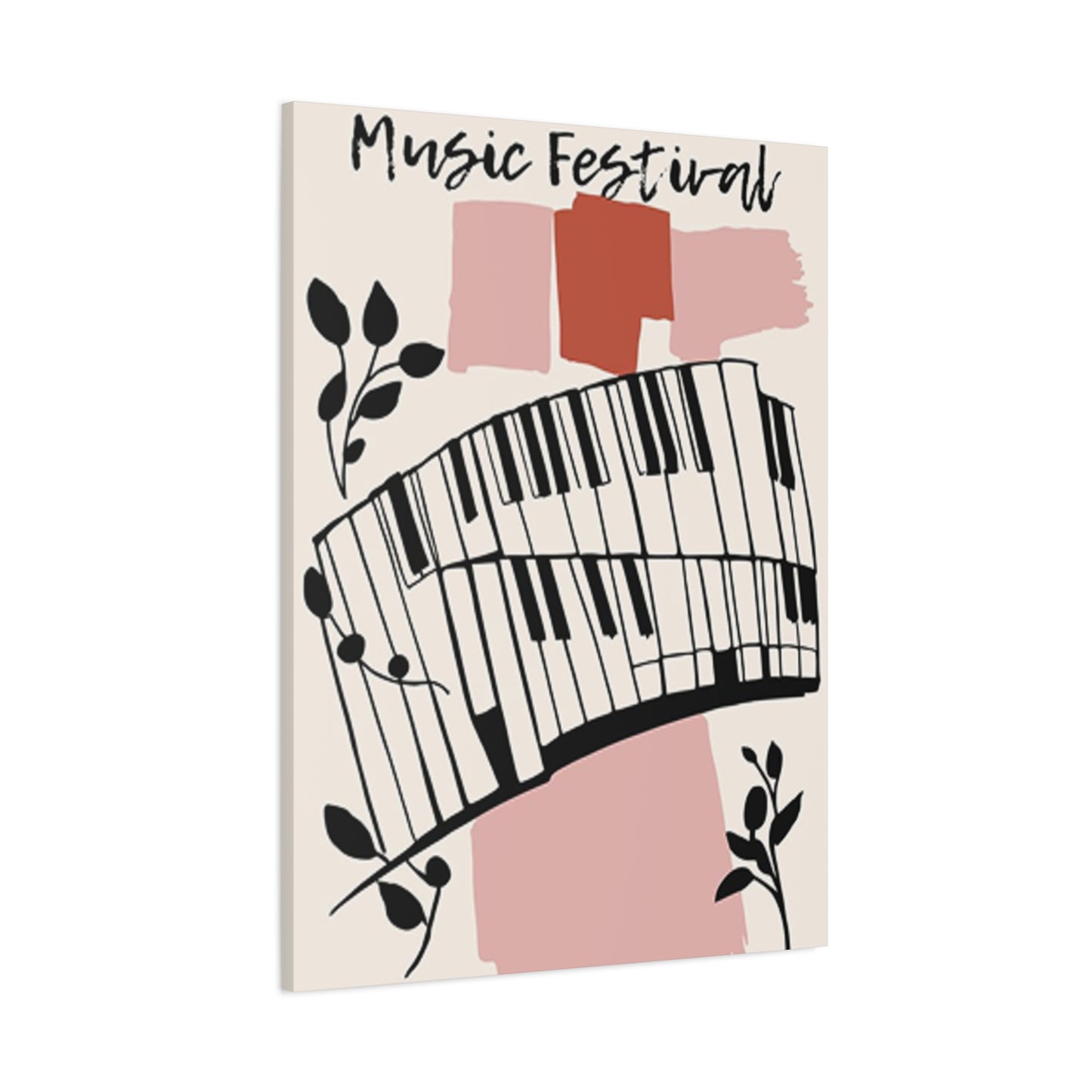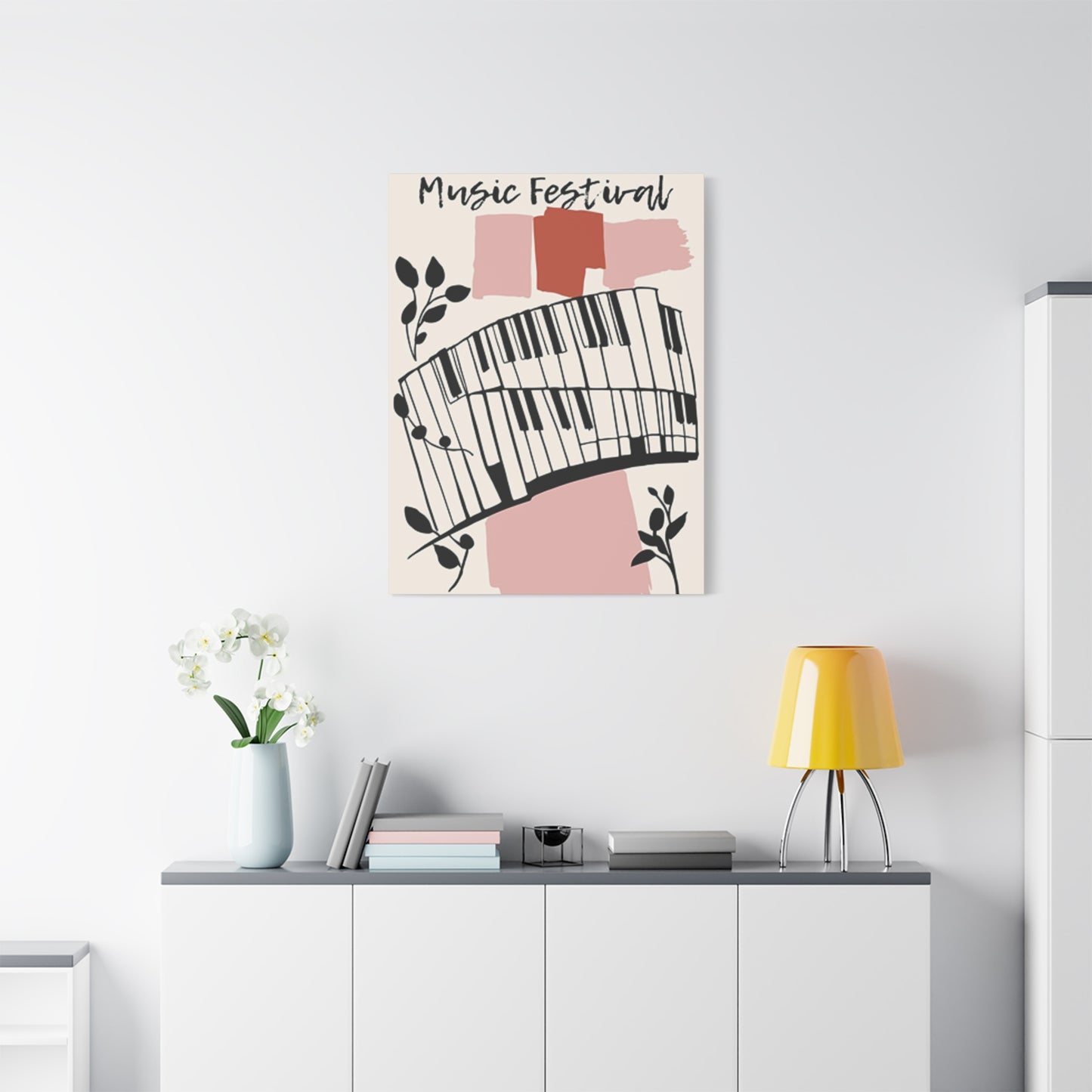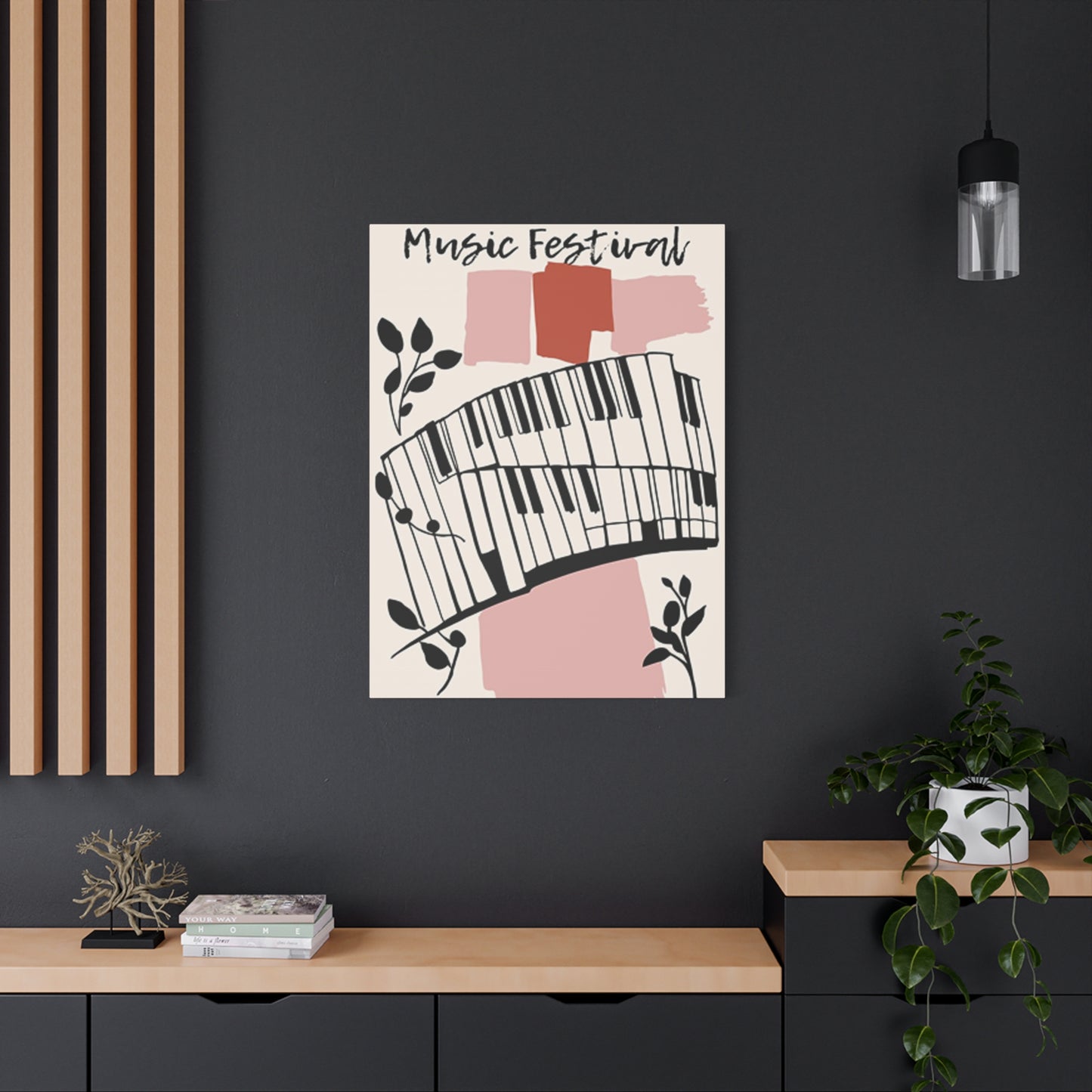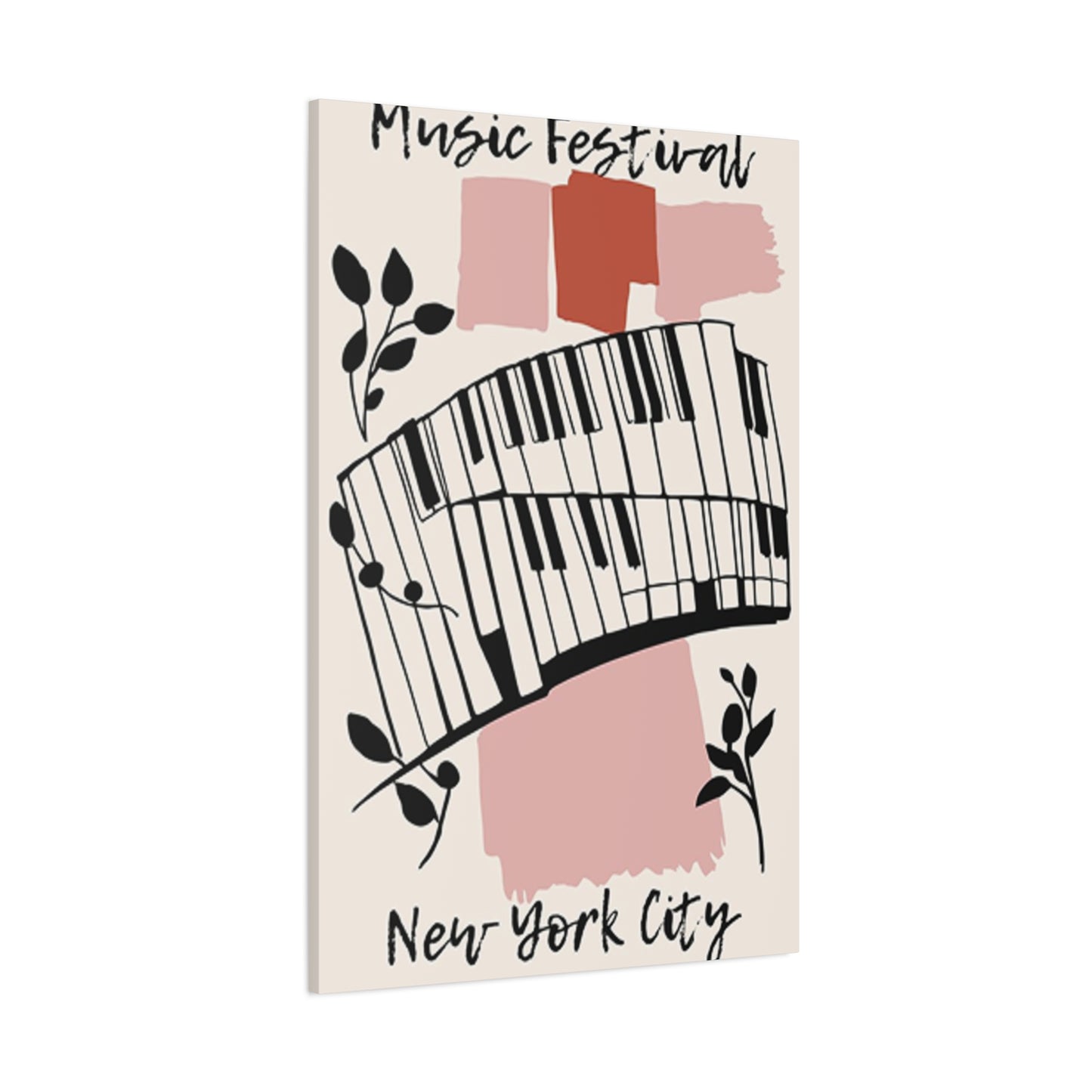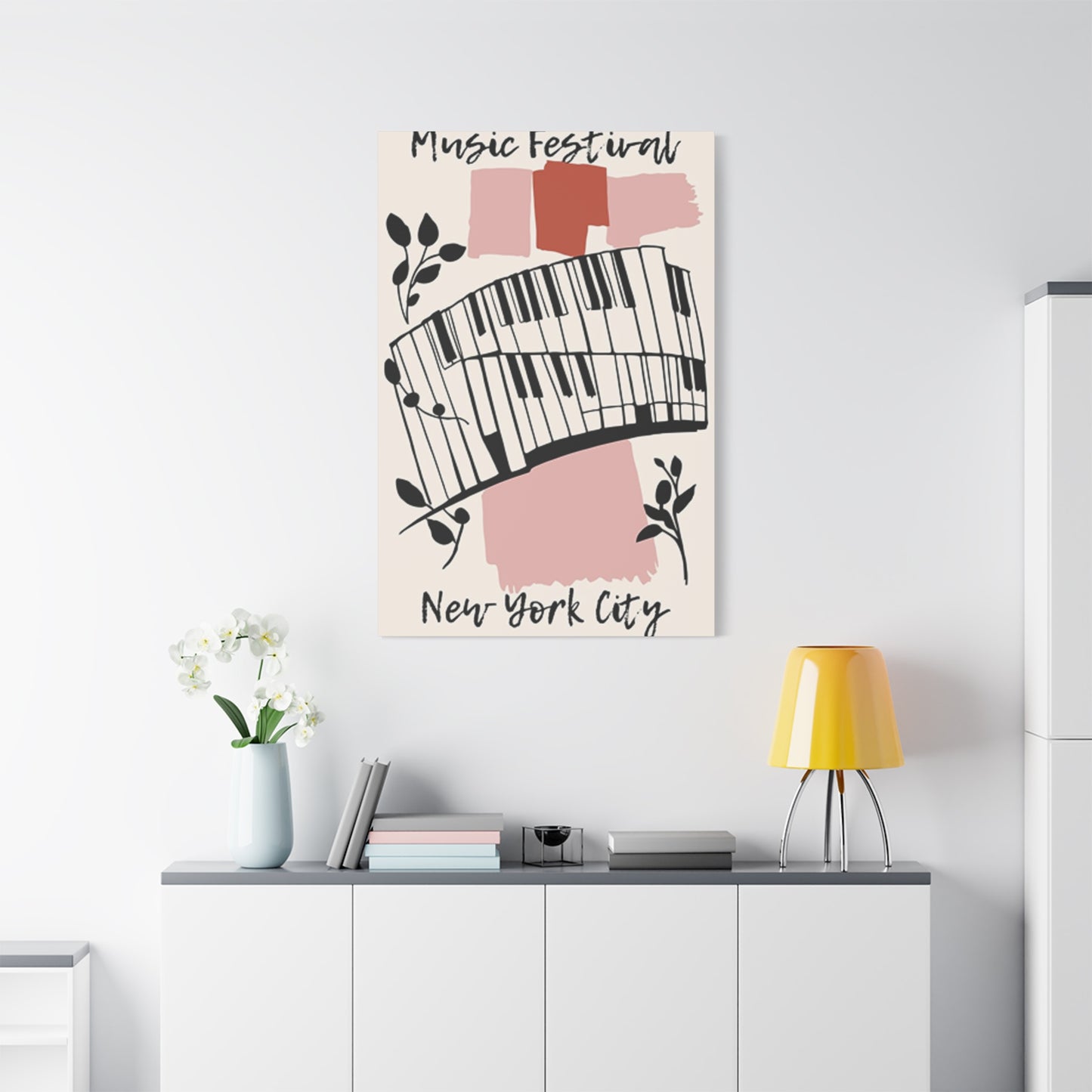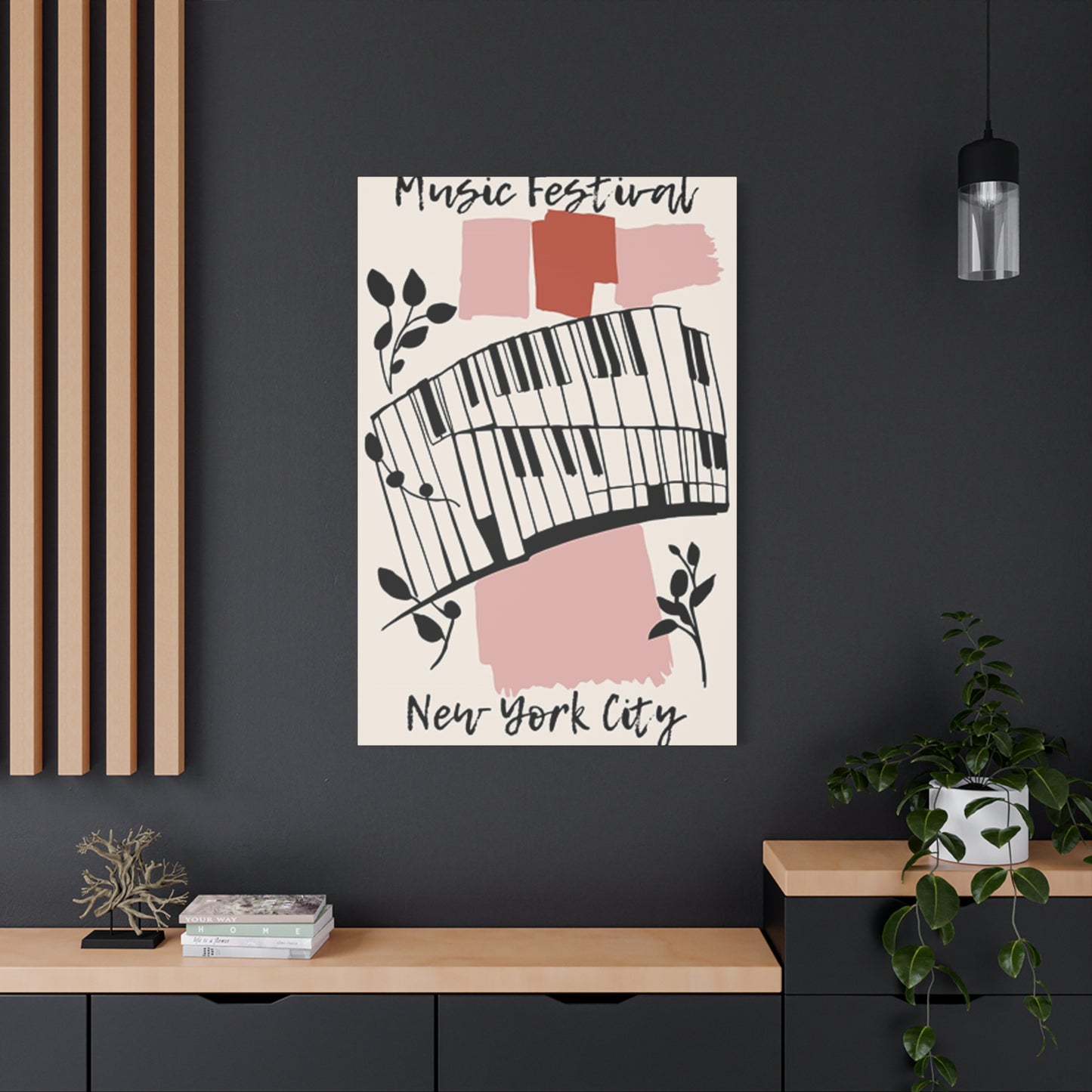NYC Music Festival Wall Art: Bringing Concert Energy Into Your Living Space
New York City pulses with an unmistakable energy that flows through its streets, venues, and festival grounds. The musical heartbeat of this iconic metropolis has inspired countless artists, musicians, and dreamers who flock to experience its legendary performances. Now, that same vibrant atmosphere can transform your living space through carefully curated canvas artwork that captures the essence of the city's most unforgettable musical moments. This artistic movement bridges the gap between live performance art and home decoration, allowing enthusiasts to surround themselves with the electric atmosphere of concert nights and festival weekends without leaving their homes.
The concept of translating musical experiences into visual art has evolved dramatically over recent years. What once seemed like an impossible task—capturing the ephemeral nature of live performance—has become an accessible reality through innovative artistic techniques and modern printing technology. These pieces serve as more than mere decoration; they function as portals to cherished memories, conversation starters, and daily reminders of the transformative power of live music. Whether you attended the event personally or simply admire the cultural significance of these gatherings, festival-inspired artwork offers a unique way to celebrate the intersection of sound and visual creativity.
Capture the NYC Music Vibe on Canvas
New York City stands as an undisputed capital of musical innovation and cultural expression. From jazz clubs in Harlem to punk venues in the East Village, from hip-hop's birthplace in the Bronx to the indie rock scenes of Brooklyn, this city has consistently pushed the boundaries of what music can be. The visual representation of this musical heritage requires artists who understand not just the technical aspects of their craft but also the emotional resonance that makes certain moments unforgettable.
Canvas artwork depicting the city's music scene draws from a rich tradition of concert photography, street art, and cultural documentation. These pieces often feature dynamic compositions that mirror the energy of the performances themselves. Bold color palettes echo the lighting designs of stage productions, while compositional choices reflect the movement and flow of crowds united in shared experience. Artists working in this space must balance technical precision with emotional authenticity, ensuring each piece communicates the unique atmosphere of live musical performance.
The process of creating canvas art inspired by musical events involves multiple stages of artistic interpretation. Photographers capture raw moments during performances, documenting the interplay of light, motion, and human emotion. These images then undergo careful curation and enhancement, with artists making deliberate choices about color grading, contrast, and composition to amplify the emotional impact. The transition from digital file to physical canvas adds another dimension, as texture and materiality transform the viewing experience into something tangible and present.
Different neighborhoods within the city offer distinct musical flavors that translate into varied artistic styles. Greenwich Village's folk music heritage might inspire warm, intimate compositions featuring acoustic instruments and small venue settings. The electronic dance music scene of warehouse parties could manifest as abstract, geometric designs with vibrant neon color schemes. Jazz culture from various eras might appear in sophisticated black and white compositions or period-appropriate color treatments that evoke specific decades of musical history.
The authenticity of these artworks matters tremendously to collectors and music enthusiasts. Genuine connection to real events, venues, and cultural moments elevates these pieces beyond generic decoration. When artists have personal experience with the scenes they depict, that knowledge informs every creative decision, from the accuracy of venue details to the authentic representation of audience demographics and fashion. This level of attention to detail creates artwork that resonates deeply with those who share similar musical passions.
Size and scale play crucial roles in how effectively canvas art captures the music festival experience. Larger pieces can immerse viewers in the scene, creating a window-like effect that transports them back to specific moments. Smaller works might focus on intimate details—a guitarist's hands, a singer's silhouette, the glow of stage lights reflecting off an enthusiastic crowd. Multi-panel installations offer opportunities to tell stories across several connected images, building narrative momentum that mirrors the arc of a concert or festival day.
The technical quality of canvas printing significantly impacts the final result. High-resolution source images ensure crisp details that maintain their clarity even when enlarged to substantial sizes. Color accuracy becomes paramount when attempting to recreate the vivid lighting designs that characterize modern concerts. The canvas material itself contributes texture that adds depth and visual interest, transforming flat digital images into objects with physical presence and artistic legitimacy.
Framing choices further enhance the presentation of music-inspired canvas art. Gallery-wrapped edges allow the image to continue around the sides of the frame, creating a polished look that requires no additional framing. Traditional frames can add formality or complement specific decor styles, while floating frames create sophisticated shadow effects that emphasize the three-dimensional nature of canvas prints. These presentation choices should align with both the artwork's character and the space where it will be displayed.
Seasonal music events throughout the calendar year provide fresh inspiration for new artwork. Summer festivals in city parks, winter holiday concerts, spring outdoor shows, and autumn album release parties each carry distinct atmospheric qualities. Artists who capture these temporal variations help collectors build rotating displays that reflect the changing rhythm of the city's musical calendar. This approach keeps home decor dynamic and responsive to the ongoing evolution of the cultural landscape.
The emotional connection people feel toward specific performances or venues cannot be overstated. A concert attended during a significant life moment—a first date, a celebration, a period of personal transformation—carries psychological weight that ordinary decoration cannot match. Canvas art depicting these meaningful events becomes a form of personal storytelling, a visual journal entry that preserves not just an image but an entire constellation of associated memories and feelings.
Feel the Beat of NYC Festivals at Home
Music festivals represent concentrated expressions of cultural energy, where thousands gather with shared purpose to experience art collectively. The atmosphere at these events defies easy description—part celebration, part communion, part spontaneous creation of temporary community. Translating this multifaceted experience into home decor requires artistic sensitivity and technical skill, but the results can profoundly impact daily living environments.
Festival artwork succeeds when it captures specific elements that trigger recognition and emotional response. The distinctive silhouette of a city skyline behind an outdoor stage immediately locates viewers in a particular place and time. Crowd formations, with raised hands and illuminated phone screens, communicate the shared joy of musical experience. Stage designs, which have become increasingly elaborate and visually stunning, offer architectural interest and dynamic visual focal points.
Color psychology plays a significant role in how festival-themed artwork affects interior spaces. The warm oranges and pinks of sunset performances create welcoming, energetic environments suitable for social spaces. Deep blues and purples of evening shows offer calming sophistication appropriate for personal sanctuaries. Bright, saturated primaries reflecting electronic music aesthetics inject playfulness and contemporary edge into modern interiors. Understanding these relationships helps collectors choose pieces that enhance rather than conflict with their existing design schemes.
The human element in festival photography distinguishes exceptional pieces from merely competent ones. Capturing genuine moments of joy, surprise, connection, and transcendence requires photographers to be fully present and responsive during events. These authentic human moments create emotional anchors within compositions, giving viewers specific points of empathy and identification. Whether it's a couple embracing during a favorite song or a solitary figure lost in musical reverie, these human touches make artwork relatable and emotionally resonant.
Different festival genres demand different artistic approaches. Rock concerts might favor gritty, high-contrast treatments that emphasize raw energy and rebellion. Electronic music events could embrace futuristic, neon-saturated aesthetics that reflect the genre's forward-looking orientation. Folk and indie festivals might adopt naturalistic color palettes and organic compositions that honor the genres' roots in authentic expression. Hip-hop and R&B performances could incorporate urban art influences, bold graphics, and street culture references.
The physical act of attending festivals involves distinctive sensory experiences beyond just sound. The feel of summer grass beneath feet, the smell of food vendors, the press of crowds, the visual spectacle of light shows—all these elements combine to create holistic memories. While canvas art primarily addresses visual sensibilities, the best examples suggest these other sensory dimensions, creating pieces that trigger full memory recall rather than simple image recognition.
Location-specific festivals develop unique identities that dedicated artwork can celebrate. Events held in recognizable city locations carry additional layers of meaning through their geographical specificity. A festival staged against the backdrop of Manhattan's skyline communicates something fundamentally different from one held in a rural setting. These locational elements ground the artwork in particular places, strengthening emotional connections for those familiar with the venues.
Annual festival traditions create opportunities for collectors to build thematic series over time. Someone might acquire artwork from their first festival attendance, then add pieces from subsequent years, building a visual timeline of their engagement with particular events or musical movements. This approach to collection building adds narrative dimension to home decor, transforming walls into curated personal exhibitions that chronicle artistic passions and life experiences.
The social dimension of festival attendance finds expression in artwork that celebrates collective experience. Wide shots showing expansive crowds unified in shared appreciation communicate the powerful sense of belonging these events create. These images remind viewers that musical passion connects individuals across demographics, creating temporary communities bound by aesthetic appreciation rather than conventional social structures. This egalitarian spirit makes festival art particularly meaningful in increasingly fragmented contemporary culture.
Technological advances in performance production have dramatically increased the visual spectacle of modern festivals. Elaborate stage designs, sophisticated lighting rigs, large-scale video displays, and even drone shows create unprecedented opportunities for striking imagery. Artists working with festival content now access visual richness that earlier generations could only imagine. This technological enhancement of live performance translates beautifully into canvas artwork that showcases the medium's ability to preserve complex visual information.
Wall Art Inspired by New York's Music Scene
The musical heritage of New York stretches across decades and encompasses countless genres, movements, and cultural moments. From the cotton clubs of the jazz age to the punk explosion at venues that have since become legendary, from the birth of hip-hop in community centers to the electronic music revolution in downtown clubs, this city has consistently served as an incubator for musical innovation. Wall art that draws inspiration from this rich history offers viewers connection to something larger than individual performances—it links them to ongoing cultural narratives that have shaped modern music.
Historical music venues carry tremendous cultural significance and provide compelling subject matter for artistic interpretation. Legendary spaces where careers launched and movements coalesced become pilgrimage sites for serious music enthusiasts. Artwork depicting these venues honors their contributions while making them accessible to those who never experienced them firsthand. Black and white photography of iconic establishments captures their gritty authenticity, while color treatments might emphasize specific eras or aesthetic movements associated with particular locations.
Street art and graffiti have long intersected with musical culture in urban environments. Many musicians emerged from communities where visual art covered every available surface, and this cross-pollination of artistic forms creates natural opportunities for hybrid artwork. Pieces that combine musical imagery with street art aesthetics honor the interconnected nature of urban creative culture. These works speak to audiences who appreciate art that feels raw, immediate, and connected to lived experience rather than institutional validation.
Genre-specific visual languages have developed alongside musical movements, creating recognizable aesthetic signatures. Jazz imagery often features dramatic lighting, smoky atmospheres, and intimate venue settings that reflect the music's sophistication and emotional depth. Punk aesthetics embrace DIY production values, bold typography, and confrontational imagery that mirrors the genre's rebellious spirit. Hip-hop artwork might incorporate urban landscapes, cultural symbols, and bold graphic treatments that reference the genre's visual culture. Understanding these genre-specific vocabularies helps collectors choose artwork that authentically represents their musical passions.
The intimate club scene offers distinct visual opportunities compared to large festival environments. Small venue performances allow artists to capture details invisible in massive crowd settings—the concentration on a musician's face, the intricate beauty of instruments, the subtle interactions between performers and front-row audiences. These intimate perspectives provide contrast and variety within collections otherwise dominated by large-scale festival imagery.
Music photography as a fine art discipline has evolved significantly with technological advancement. Early concert photography faced severe technical limitations regarding available light and film sensitivity. Modern digital equipment allows photographers to capture images that would have been impossible just decades ago. This technical evolution has democratized music photography while simultaneously raising expectations for image quality and artistic vision. The best contemporary music photographers balance technical mastery with genuine understanding of their subjects, creating images that satisfy both aesthetic and documentary purposes.
The relationship between musicians and visual artists creates interesting collaborative possibilities. Some canvas artwork emerges from official relationships with performers, festivals, or venues, carrying additional authenticity and often supporting artists directly. Limited edition prints authorized by musicians themselves become collectible items that combine aesthetic appeal with cultural significance. These official collaborations ensure that artwork respects intellectual property while giving fans access to high-quality representations of their favorite artists.
Urban landscapes provide context for musical culture, and many effective pieces incorporate cityscapes alongside performance imagery. The vertical drama of skyscrapers, the horizontal sprawl of bridges, the intimate geometry of neighborhood streets—these visual elements ground musical moments in specific places. For residents and visitors alike, imagery that combines musical culture with recognizable urban features creates powerful sense-of-place connections that transcend simple decoration.
Temporal changes in the music scene offer rich material for artistic exploration. Comparing imagery from different decades reveals shifts in fashion, venue design, production technology, and cultural attitudes. Collections that span multiple eras create visual timelines showing how musical culture has evolved while maintaining core elements of communal experience and artistic expression. This historical perspective adds intellectual depth to decorative choices, transforming walls into educational resources as well as aesthetic environments.
The diversity of New York's musical communities deserves visual representation that honors varied cultural traditions. From Latin music scenes to Caribbean influences, from African diaspora contributions to Asian American artistic movements, the city's music reflects its demographic complexity. Artwork that celebrates this diversity provides windows into communities that might be unfamiliar to some viewers while offering recognition and validation to those with direct cultural connections.
NYC Music Festival Energy, Framed
The concept of framing extends beyond physical borders around images to encompass how we contextualize and present musical experiences within our living spaces. Proper framing—both literal and metaphorical—determines whether artwork successfully channels festival energy or simply occupies wall space. Understanding the principles of effective presentation helps collectors maximize the emotional and aesthetic impact of their music-inspired pieces.
Physical framing options span a wide spectrum, from minimalist gallery wraps to elaborate traditional frames. Gallery-wrapped canvases stretch the printed image around wooden frames, creating clean, contemporary presentations that work especially well with modern decor. The image appears to float against the wall, emphasizing its content without additional visual elements competing for attention. This approach suits bold, graphic images that benefit from uncluttered presentation.
Traditional wooden or metal frames add formality and can help artwork integrate with more classical interior design schemes. Ornate frames might seem inappropriate for contemporary music imagery, but thoughtful pairings can create interesting juxtapositions that highlight the tension between traditional artistic formats and contemporary cultural content. Simple black or white frames provide neutral borders that focus attention inward while maintaining clear boundaries between artwork and surrounding walls.
Floating frames create sophisticated shadow effects by suspending canvas within slightly larger frame structures. This presentation style emphasizes the three-dimensional nature of canvas prints while adding visual interest through the play of light and shadow. The technique particularly suits high-quality images with excellent detail, as the elevated presentation signals the artwork's importance and invites closer examination.
Acrylic or glass glazing offers additional protection and visual enhancement options. While traditional canvas typically remains unglazed, some contemporary presentations incorporate clear coverings that create distinctive visual effects. Acrylic can reduce glare compared to glass while offering excellent protection against dust and physical damage. However, glazing adds expense and weight, and some purists feel it creates unwanted distance between viewers and artwork.
The scale of framing should correspond to both the image content and the display environment. Large, dramatic festival shots deserve substantial presentations that command attention and anchor visual arrangements. Smaller, intimate images might benefit from more modest framing that invites closer inspection. Understanding the relationship between image content, frame size, and viewing distance helps collectors make effective presentation decisions.
Grouping multiple pieces creates opportunities for visual storytelling that single images cannot achieve. A collection documenting different moments from a single event can recreate the temporal flow of that experience. Pieces representing various venues or festivals might explore thematic connections between different musical traditions. Careful consideration of arrangement—including spacing, alignment, and visual rhythm—determines whether grouped pieces enhance each other or create visual confusion.
Wall color and lighting dramatically affect how framed artwork appears in situ. Light walls make colors appear more vibrant and keep spaces feeling open, while dark walls can create dramatic contrast that makes artwork pop. Natural light changes throughout the day, affecting how artwork appears at different times. Dedicated picture lighting ensures consistent presentation while adding gallery-quality sophistication to home environments.
The psychological concept of framing extends to how we mentally categorize and value experiences. By literally framing festival moments as artwork worthy of display, we affirm their importance in our lives and personal narratives. This act of elevation transforms ephemeral experiences into permanent fixtures, asserting that these cultural moments deserve ongoing attention and reflection. The framing decision thus becomes a statement about values and priorities beyond simple aesthetic preference.
Rotation and seasonal changes keep displays fresh and responsive to current circumstances. Some collectors maintain rotating inventories of music artwork, changing displays to reflect current listening habits, upcoming concert attendance, or simply to prevent visual fatigue. This dynamic approach to collection management keeps living spaces evolving and ensures that artwork continues to engage attention rather than fading into background familiarity.
Conservation considerations affect long-term enjoyment of music-inspired artwork. Canvas prints should avoid direct sunlight, which can fade colors over time. Humidity control prevents material degradation and protects against mold or warping. Regular dusting maintains appearance, while professional cleaning may occasionally be necessary for pieces displayed in kitchens or other environments where airborne particles accumulate. Proper care ensures that artwork continues delivering visual impact for many years.
Turn Up the Volume with Canvas Prints
Canvas prints offer unique advantages for reproducing music-inspired imagery compared to other print media. The texture of canvas adds visual interest and artistic legitimacy, elevating photographic images beyond what standard paper prints can achieve. This textured surface catches light differently depending on viewing angle, creating subtle visual dynamics that reward extended observation. For music imagery specifically, canvas texture can enhance the sense of energy and movement inherent in performance photography.
The durability of properly produced canvas prints makes them practical choices for high-traffic areas where music enthusiasts gather socially. Unlike paper prints behind glass, canvas withstands minor impacts and doesn't shatter if knocked from walls. This resilience particularly matters in spaces where energetic gatherings might pose risks to more fragile artwork. The practical durability doesn't compromise aesthetic quality, making canvas an ideal intersection of form and function.
Color reproduction on canvas has improved dramatically with advances in inkjet printing technology. Modern pigment-based inks achieve color accuracy and saturation that rivals or exceeds traditional photographic processes. The combination of high-quality source files, professional color management, and premium canvas materials produces results that satisfy even discerning collectors. Proper calibration ensures that the vibrant lighting of concert imagery translates effectively to physical prints.
Sizing flexibility represents another significant advantage of canvas printing. Images can be scaled to virtually any dimension without the structural limitations of framed glass. Creating truly massive pieces that dominate entire walls becomes practical and affordable. This scalability allows collectors to make bold statements in spaces with high ceilings or expansive walls, bringing appropriate visual weight to architectural environments that would overwhelm smaller artwork.
The tactile quality of canvas creates different viewing experiences compared to glossy or matte paper prints. Visitors often feel compelled to examine canvas pieces more closely, appreciating the interplay of ink and textile surface. This physical curiosity extends engagement beyond initial visual impact, creating opportunities for deeper appreciation of compositional and technical elements. The touchable nature of canvas makes artwork feel more approachable and less precious than museum-style presentations.
Edge treatment options allow for creative presentation decisions. Gallery wraps extend images around frame edges, creating seamless visual experiences. Mirror wraps reflect edge portions of images, providing visual continuity without interrupting primary compositions. Solid color wraps offer clean borders that frame images without additional visual information. These edge decisions subtly influence how viewers perceive and interact with artwork.
Canvas printing democratizes access to high-quality art reproduction, making museum-level presentation available at accessible price points. What once required expensive custom framing now emerges ready to hang from production facilities. This accessibility has expanded the market for music-inspired artwork, allowing more enthusiasts to surround themselves with imagery reflecting their passions without prohibitive investment.
Environmental considerations increasingly influence production choices, with many print services adopting eco-friendly practices. Water-based inks, sustainably sourced canvas materials, and responsible waste management address concerns about environmental impact. For socially conscious collectors, choosing providers with strong environmental commitments aligns aesthetic purchases with ethical values.
Customization options extend beyond simple size selection to include various finishing treatments. Protective coatings enhance durability and resist UV fading. Texture treatments can amplify or modify canvas weave patterns. Color adjustments allow for personalization of standard images to match specific decor requirements. These customization possibilities help collectors create pieces that feel uniquely tailored to their spaces and preferences.
The relationship between print quality and source material cannot be overstated. Even the finest canvas and printing equipment cannot compensate for low-resolution or poorly composed source images. Professional music photographers who understand print reproduction ensure their captures meet technical requirements for large-format printing. Collectors should prioritize high-quality source imagery when selecting pieces, as this foundation determines ultimate visual impact.
From Stage to Studio Wall — NYC in Art
The journey from live performance to permanent wall installation involves multiple transformations, each adding layers of interpretation and meaning. Understanding this translation process helps collectors appreciate the artistry involved in creating effective music-inspired canvas pieces. What appears as simple documentation actually represents complex decisions about framing, timing, technical settings, and post-production enhancement.
The initial capture moment requires photographers to balance artistic vision with technical demands. Concert lighting creates extreme contrast situations with bright stage illumination against dark backgrounds. Photographers must choose exposure settings that preserve highlight detail without losing shadow information entirely. Movement blur from performers and audiences adds another challenge, requiring fast shutter speeds or intentional motion blur as creative choice. These technical decisions made in fractions of seconds fundamentally shape the final artwork potential.
Post-production processing transforms raw captures into polished artwork ready for printing. Color grading establishes mood and emphasizes specific elements within compositions. Contrast adjustments improve visual clarity and impact. Selective sharpening enhances critical details while maintaining organic overall appearance. Noise reduction cleans up digital artifacts from high-ISO shooting without sacrificing texture. Each adjustment moves images closer to artistic vision while respecting documentary authenticity.
Cropping and composition refinement optimize images for specific display formats. Wide panoramic captures might be reformatted for standard canvas proportions. Vertical crops can emphasize individual performers, while horizontal treatments showcase crowd expanses. These compositional choices dramatically affect narrative emphasis and emotional impact. Skilled artists understand how subtle reframing redirects attention and alters how viewers interpret scenes.
The selection process for publishable work involves rigorous curation. Professional music photographers might shoot thousands of frames during a single event, yet only a handful meet standards for reproduction as fine art. Selection criteria include technical excellence, compositional strength, emotional resonance, and narrative clarity. This winnowing process ensures that only truly exceptional moments reach public availability.
Collaboration between photographers, venues, performers, and print producers creates complex rights and permission environments. Ethical producers ensure proper licensing for all imagery, respecting intellectual property while creating paths for commercial use. Official collaborations between artists and venues often produce the most authentic and culturally significant artwork, as all parties work toward shared goals of cultural documentation and celebration.
The translation from digital file to physical object introduces new considerations. Color spaces must be managed carefully to ensure on-screen appearance translates accurately to print. Resolution requirements vary with final output size, with larger prints demanding higher-resolution source files. File preparation specialists optimize images for specific printing processes, ensuring technical specifications align with production capabilities.
Quality control during printing maintains standards and catches potential issues before completion. Test prints allow for color verification and adjustment. Print operators monitor output throughout production runs, ensuring consistency across multiple pieces. Post-print inspection catches defects before products ship to customers. These quality assurance steps separate professional operations from consumer-grade production.
The final installation transforms printed canvas into activated artwork that engages with its environment. Hanging height affects viewer engagement, with eye-level center points generally creating optimal viewing experiences. Lighting design showcases artwork effectively while avoiding glare or hot spots. Spatial relationships between multiple pieces create visual rhythms that guide attention through curated arrangements. These installation decisions complete the transformation from stage moment to permanent artistic fixture.
The cyclical nature of music creation and consumption creates ongoing opportunities for new artwork. As artists release albums, festivals announce lineups, and venues host performances, fresh visual material emerges for documentation and artistic interpretation. This constant renewal keeps music-inspired art vital and relevant, preventing the genre from feeling dated or exhausted. Collectors can continually refresh their spaces with imagery reflecting current musical moments while maintaining classic pieces documenting historical significance.
Relive the Festival with Every Glance
The power of visual reminders to trigger complete memory recall makes festival artwork emotionally significant beyond its aesthetic qualities. Neuroscience research demonstrates that visual cues activate associated memories, recreating not just facts about events but emotional states and sensory impressions. A well-chosen canvas print can function as a memory portal, instantly transporting viewers back to specific moments with remarkable fidelity.
The phenomenon of nostalgia plays a significant role in why people surround themselves with imagery from meaningful experiences. Nostalgia serves important psychological functions, providing continuity between past and present selves while affirming that life contains meaningful, memorable experiences. Festival artwork becomes a tool for managing nostalgia in healthy, life-enhancing ways, keeping cherished memories accessible without dwelling unproductively on the past.
Social connections formed during festival experiences add another dimension to artwork significance. Many attendees forge or strengthen friendships during these events, with shared musical experiences creating lasting bonds. Artwork depicting festivals attended with specific companions triggers memories not just of performances but of relationships and social connections. Displaying these pieces honors friendships and celebrates the role of music in bringing people together.
The concept of liminality—existing in threshold states between ordinary life and extraordinary experience—applies powerfully to festival attendance. These events create temporary worlds with their own rules, norms, and possibilities. Returning to regular life after transformative festival experiences can feel jarring, creating desire for tangible connections to those special states. Canvas artwork serves as a bridge, keeping extraordinary experiences present even while navigating ordinary routines.
Repeated exposure to meaningful imagery creates cumulative emotional effects. Unlike one-time viewing experiences in galleries or museums, home-displayed artwork enters daily awareness repeatedly over extended periods. This repetition deepens emotional connections and allows for ongoing discovery of new details and interpretations. Festival canvas prints gain rather than lose meaning over time, as they accumulate layers of associated thoughts and feelings.
Different life stages bring different perspectives to the same artwork. A festival attended during young adulthood might represent freedom and possibility, while years later the same imagery could evoke youth and vitality. Decades down the line, it might symbolize a lifetime of musical passion and cultural engagement. This evolving relationship with static images adds temporal depth, making artwork companions through life's journey rather than mere decoration.
The sharing aspect of home-displayed artwork extends festival experiences into social contexts. Guests notice and inquire about distinctive pieces, creating opportunities for storytelling and connection. Discovering shared musical interests through displayed artwork can spark friendships and deepen existing relationships. In this sense, festival canvas prints remain socially active, continuing to facilitate the human connections that made the original events meaningful.
Meditation and mindfulness practices sometimes incorporate visual focal points, and music-inspired artwork can serve this function. Taking moments to deeply observe a festival print, reconstructing sensory memories and emotional states, creates brief retreats from daily stress. This contemplative use of artwork adds therapeutic dimension to its presence in living spaces.
The identity-affirming function of displayed artwork matters particularly to those for whom music constitutes a core part of self-concept. Surrounding oneself with visual representations of musical passion communicates to self and others that this isn't a casual interest but a fundamental aspect of identity. This visual self-declaration can feel empowering and authentic, creating living spaces that honestly reflect inhabitants' values and passions.
Seasonal and temporal associations embedded in festival imagery create rhythmic connections to annual cycles. Summer festival artwork might particularly resonate during winter months, offering psychological warmth and anticipation of returning warm seasons. Conversely, displaying such imagery year-round maintains connections to preferred seasons and activities, refusing to let experience be limited by calendar constraints. These temporal relationships add another layer of meaning to how artwork functions within lived experience.
Canvas Art for True NYC Music Fans
Authenticity matters tremendously in subcultures built around musical passion. True enthusiasts can distinguish between generic music-themed decoration and artwork that demonstrates genuine understanding of specific scenes, venues, and cultural contexts. Canvas art that succeeds with this discerning audience must exhibit both technical quality and cultural literacy, proving its creators possess insider knowledge and respect for the subject matter.
The concept of gatekeeping within music communities can be problematic, yet standards for authenticity serve important functions in maintaining cultural integrity. Artwork that trades on superficial associations with music culture without understanding its deeper meanings risks trivializing significant cultural movements. Conversely, pieces created by artists with genuine engagement bring depth and resonance that enriches both personal collections and broader cultural discourse.
Specific venue details serve as authenticity markers that knowledgeable fans immediately recognize. The unique architecture of particular performance spaces, distinctive design elements of festival stages, accurate representation of neighborhood contexts—these details signal whether artists know their subjects firsthand or simply reproduce generic music imagery. Collectors with deep scene knowledge particularly value pieces that demonstrate this attention to authentic detail.
Period accuracy matters when artwork references historical moments in musical culture. Fashion, equipment, venue configurations, and cultural contexts change over time, and mixing elements from different eras creates false historical records. Artists who carefully research their subjects and ensure accuracy honor both the past and audiences who value historical fidelity. This care elevates artwork from decoration to cultural documentation.
The relationship between commercial and underground music scenes introduces interesting tensions regarding authenticity and accessibility. Major label artists and large-scale commercial festivals generate most widely available imagery, while underground scenes deliberately resist mainstream documentation. Canvas art that represents these underground movements faces challenges balancing accessibility with respecting communities that value exclusivity. Navigating these tensions requires cultural sensitivity and ethical consideration.
Limited edition prints and exclusive releases appeal to collectors seeking artwork that maintains specialness and rarity. While canvas printing technology enables mass production, deliberate limitation preserves collectibility and value. Numbered editions, artist signatures, and collaboration with musicians themselves add layers of authenticity and desirability. These approaches acknowledge that for serious collectors, scarcity and provenance matter alongside aesthetic qualities.
The intersection of music fandom and art collecting creates interesting economic dynamics. Music enthusiasts may invest significantly in concert tickets and recordings but hesitate before spending comparable amounts on visual art. Educating potential collectors about the value proposition of high-quality canvas prints helps overcome these hesitations. Understanding artwork as permanent rather than consumable purchases shifts perspective, making initial investments more palatable when amortized across years of daily enjoyment.
Documentation of ephemeral moments gives music artwork archival significance beyond personal nostalgia. Venues close, scenes evolve, performers retire, and cultural moments pass into history. Photography and artwork that captured these fleeting realities gain historical importance as tangible records of vanished worlds. Collectors contributing to cultural preservation through their purchases participate in larger projects of memory and documentation.
The role of music journalism and criticism intersects with visual art in interesting ways. Written documentation provides context and interpretation that enhances understanding of visual material. Canvas artwork paired with knowledge of the cultural moments depicted achieves deeper resonance than images alone. Encouraging collectors to research the contexts behind their chosen pieces enriches appreciation and engagement.
Community connections formed through shared collecting interests create networks of enthusiasts who trade information, share discoveries, and celebrate common passions. Online communities dedicated to music artwork facilitate these connections, creating spaces where geographical barriers don't prevent meaningful interaction. These communities serve important functions in validating niche interests and providing social contexts where specialized knowledge finds appreciation.
Bring Festival Nights to Your Walls
Transforming residential spaces into environments that channel festival energy requires thoughtful design choices beyond simply hanging artwork. The goal involves creating cohesive atmospheres where visual elements, lighting, spatial arrangement, and even furnishings combine to evoke the electric feeling of live music experiences. Canvas prints serve as anchors for these themed environments, establishing visual vocabularies that other design elements can reinforce and amplify.
Color coordination between artwork and surrounding decor determines whether pieces integrate harmoniously or create visual discord. Festival imagery often features bold, saturated colors that can overwhelm spaces if not carefully balanced. Picking up accent colors from artwork in throw pillows, area rugs, or decorative objects creates visual unity without overwhelming spaces with intensity. Alternatively, neutral surrounding palettes allow colorful artwork to dominate as intentional focal points.
Lighting design dramatically affects both artwork presentation and overall ambiance. Adjustable lighting systems allow spaces to shift from bright functionality during daytime to moody, atmospheric settings for evening socializing. Colored LED systems can reference the lighting aesthetics of concerts themselves, though discretion prevents crossing from evocative into garish territory. Picture lights dedicated to artwork ensure consistent presentation regardless of ambient lighting conditions.
Furniture arrangement influences how spaces facilitate music listening and social gathering. Seating oriented toward sound systems creates listening lounges where music receives focused attention. Conversational arrangements encourage social interaction similar to festival gatherings. Open floor space accommodates impromptu dancing when the mood strikes. These spatial considerations determine whether environments merely display music-themed decoration or genuinely facilitate musical engagement.
Audio system quality matters tremendously in spaces designed around musical passion. Festival artwork paired with mediocre sound reproduction creates dissonance between visual and auditory experiences. Investing in quality speakers, amplification, and acoustic treatment demonstrates commitment to holistic musical environments. The visual and sonic elements should reinforce each other, creating immersive experiences that honor the subject matter depicted in displayed artwork.
Collecting vinyl records, concert posters, instruments, and other music memorabilia creates layered environments with depth and authenticity. Canvas prints become components within larger collections rather than isolated decorative elements. Curating relationships between different collection elements tells richer stories than any single item could communicate alone. These collections grow organically over time, documenting ongoing engagement with musical culture.
The concept of themed rooms appeals to enthusiasts with space to dedicate entire areas to musical passions. A music room functions as sanctuary and social hub, place of personal retreat and communal gathering. Canvas artwork establishes visual themes while other elements—from seating to storage to lighting—support the space's musical purpose. These dedicated environments demonstrate that music isn't merely a hobby but a lifestyle priority.
Hosting listening parties and small gatherings transforms music-focused spaces into social centers where communities form around shared interests. Festival artwork provides conversation starters and establishes the host's credibility and passion. Creating welcoming environments where people feel comfortable exploring music together builds relationships and enriches social lives. The space itself becomes an instrument for facilitating meaningful human connection through shared artistic appreciation.
Seasonal decorating incorporating festival artwork keeps spaces dynamic and responsive to changing moods and interests. Summer months might emphasize outdoor festival imagery, while winter could feature intimate club performances. This rotation prevents visual fatigue while allowing extensive collections to cycle through display rather than remaining permanently warehoused. The changing displays mirror the ongoing nature of musical engagement, where new discoveries constantly supplement longtime favorites.
Personal expression through space design affirms identity and creates authentic living environments. Rejecting generic design in favor of personalized spaces reflecting genuine passions creates homes that feel like true sanctuaries. Festival canvas artwork serves this purpose beautifully, allowing residents to surround themselves with visual representations of experiences and values that matter most. This authenticity makes spaces more comfortable, more inspiring, and more conducive to wellbeing than environments designed primarily for others' approval.
New York Sound. City Style. Wall Ready.
The distinctive character of New York's sonic landscape results from the city's unique combination of density, diversity, and cultural ambition. Every neighborhood contributes particular flavors to an overall sound that remains unmistakably New York despite tremendous internal variation. Capturing this multifaceted identity through visual art requires understanding the specific qualities that make the city's music scene unlike any other.
Urban density creates acoustic environments impossible in less concentrated settings. Sound bounces off buildings, echoes through concrete canyons, and mingles as countless sources overlap in compressed spaces. Street musicians perform alongside traffic noise while venues stack vertically in the same buildings. This sonic layering has influenced how New York musicians compose and perform, creating musical styles adapted to compete for attention in overwhelming acoustic environments.
Conclusion
Few experiences capture the pulse of a city quite like the music festival. The rhythm of instruments, the surge of energy from the crowd, and the electric atmosphere of live performances all combine to create moments that linger long after the last note fades. NYC Music Festival Wall Art brings this same dynamic energy into your living space, transforming walls into stages where creativity, passion, and urban culture meet. Every brushstroke, photograph, or digital print captures not just the sights of a festival, but the emotions—the exhilaration, the unity, and the sheer joy that music inspires.
Bringing concert energy into your home through wall art does more than decorate; it animates your environment. A large panoramic print of festival lights against the iconic New York skyline can fill a living room with a sense of movement and excitement, while smaller canvases featuring performers or crowds convey intimacy and personal connection. The vibrant colors, bold contrasts, and dynamic compositions of festival-inspired art inject life into neutral spaces, giving your interior a sense of rhythm and motion that mirrors the pulse of the city itself.
The appeal of NYC music festival art lies in its ability to blend urban culture with universal emotional resonance. The city is a stage, and the festival is a performance of creativity, diversity, and human connection. Artworks capturing this scene act as reminders of energy and spontaneity, encouraging an uplifting atmosphere at home. They inspire creativity, spark conversations, and create a visual soundtrack for daily life—a space where every glance reconnects you with excitement, optimism, and the vibrancy of city culture.
Color, light, and composition play pivotal roles in translating festival energy into visual art. Neon hues, shimmering lights, and high-contrast imagery mimic the glow of concert stages and the movement of performers, while abstract interpretations capture the dynamic flow of sound and crowd energy. Even subtle tones and muted palettes, when skillfully executed, evoke the emotional intensity of music festivals—drawing attention to atmosphere, mood, and the interplay of people, space, and sound. This versatility allows festival wall art to complement a wide range of interior styles—from contemporary minimalism to eclectic, bohemian, or industrial-themed spaces.
Placement of NYC music festival art can dramatically influence its impact. A central wall in a living room can act as a visual focal point, setting the tone for the entire space, while a gallery-style arrangement of smaller prints creates a narrative journey through sound, city, and culture. In home offices or creative studios, these prints encourage energy, focus, and inspiration—reminding you that vibrancy and innovation are ever-present forces when approached with creativity and passion. Bedrooms or personal lounges benefit from the dynamic energy translated into visual calm; it channels excitement in a way that is uplifting but not overwhelming, balancing intensity with aesthetic harmony.
Beyond aesthetics, festival-inspired wall art conveys emotion and experience. It evokes memories of live music, the thrill of discovery, and the communal spirit of concerts. It celebrates artistry in motion, emphasizing the intersection of human expression and shared experience. The energy depicted in these pieces transforms your walls into more than decorative surfaces—they become visual stages where music, movement, and emotion are perpetually alive.
Lighting is another critical aspect that enhances the effect of NYC music festival wall art. Spotlighting, ambient backlighting, or natural sunlight reflecting on glossy surfaces can replicate the glow of concert stages, adding depth and immersive realism. This creates an environment where your space feels alive with sound and rhythm, even in the absence of actual music. The interplay of light, color, and composition ensures that every glance reminds viewers of the vitality and excitement of live performance.
Ultimately, NYC Music Festival Wall Art brings the heart of the city and the soul of music into your home. It captures the essence of live performance, the communal energy of audiences, and the dazzling spectacle of urban culture. Every piece transforms ordinary walls into immersive experiences—spaces that inspire creativity, spark joy, and energize daily life.
By integrating festival-inspired art into your interior design, you don’t just decorate—you celebrate life, music, and the vibrancy of New York City. Your walls become a stage, your home a gallery, and every day an opportunity to experience the exhilaration and inspiration of the concert. With NYC music festival wall art, the city’s pulse, the power of performance, and the magic of music converge—inviting energy, creativity, and vitality into every corner of your living space.

















